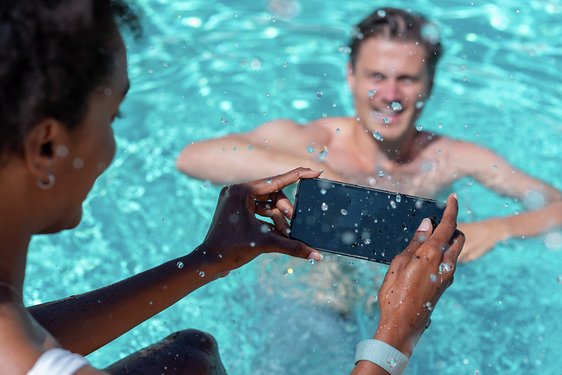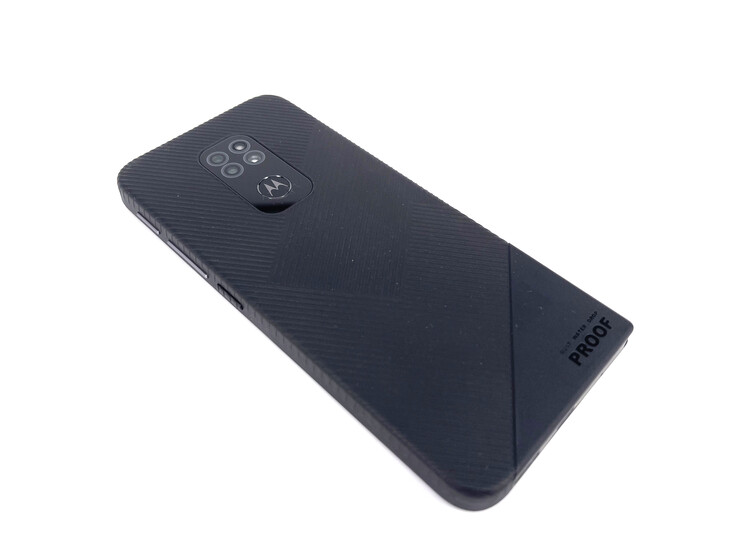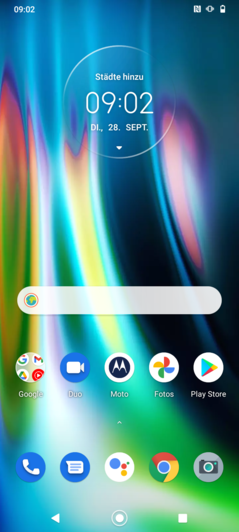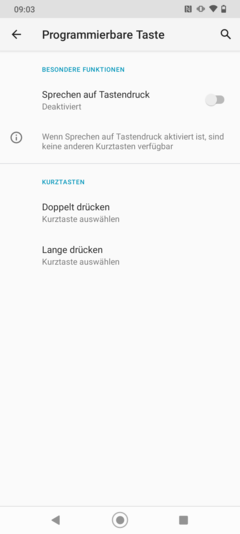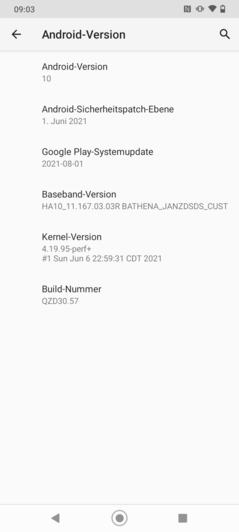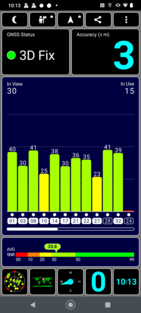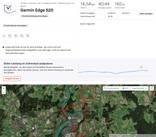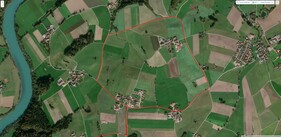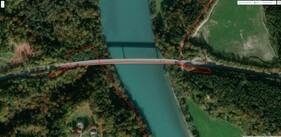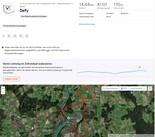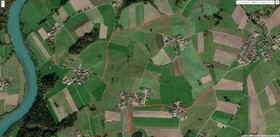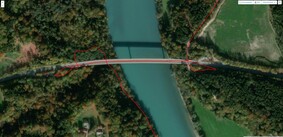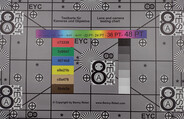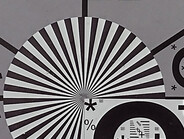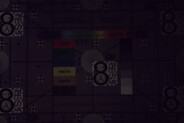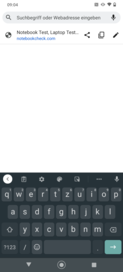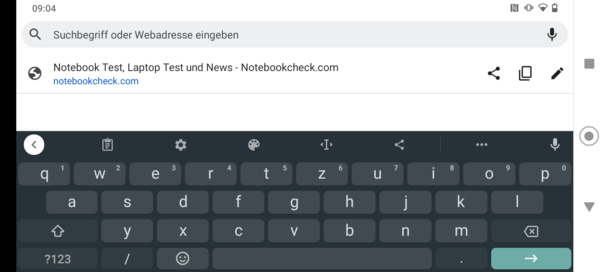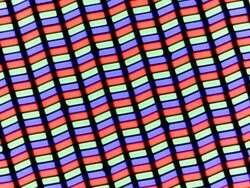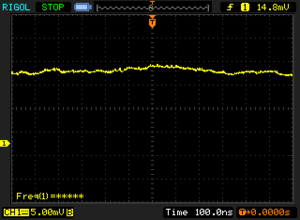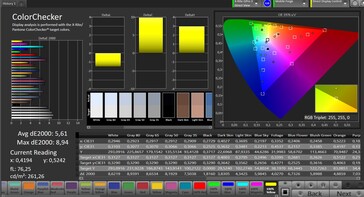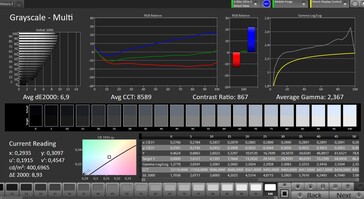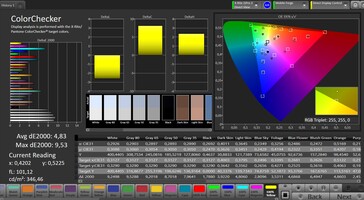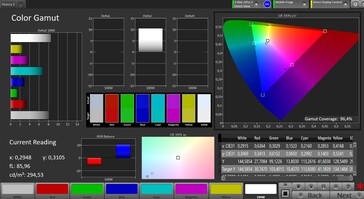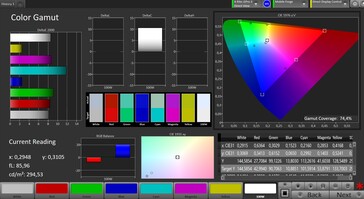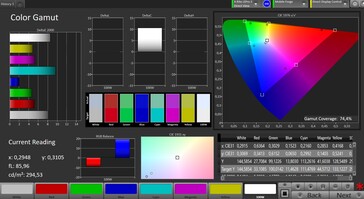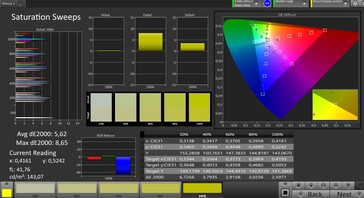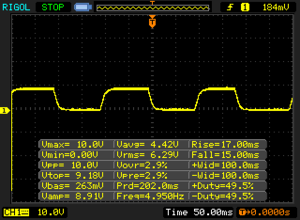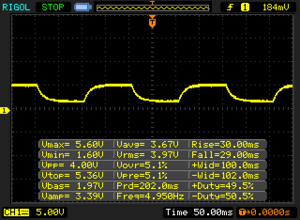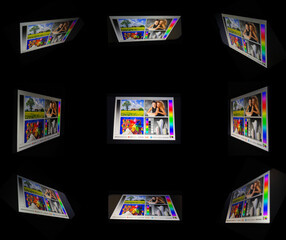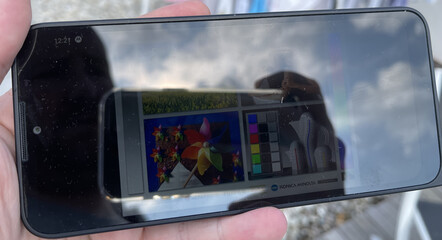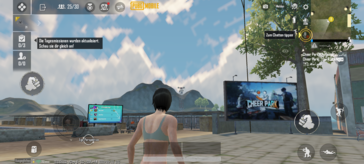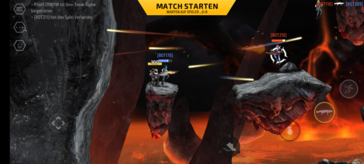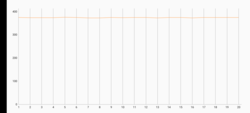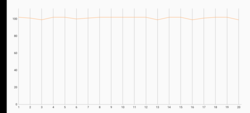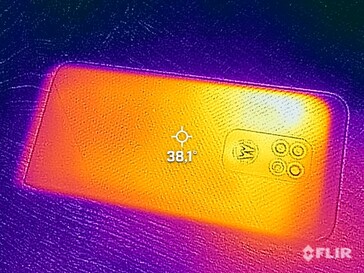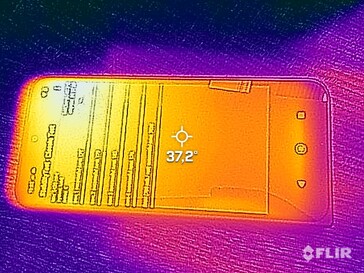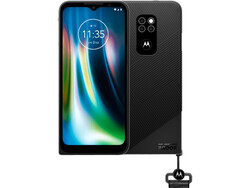Motorola Defy smartphone review - Affordable outdoor phone with interesting design
The Motorola Defy is not the first of its name: The manufacturer already released a water- and dust-proof smartphone called Defy in 2010, at that time still in the handy 3.7-inch format and with Android 2.2.
However, Motorola's Defy 2021 is of course of a completely different caliber, not only because it has almost exactly twice the screen diameter with 6.5 inches, but also because it naturally has contemporary performance and a modern operating system.
The Lenovo subsidiary has sought cooperation with the ruggedized experts from the Bullitt Group, who are responsible for CAT phones among other things, for their new outdoor phone. Thus, Motorola has an experienced partner on its side.
Our detailed review will show whether the Motorola Defy 2021 is really a good outdoor smartphone.
Possible competitors in comparison
Rating | Date | Model | Weight | Drive | Size | Resolution | Price |
|---|---|---|---|---|---|---|---|
| 78 % v7 (old) | 10 / 2021 | Motorola Defy SD 662, Adreno 610 | 232 g | 64 GB eMMC Flash | 6.50" | 1600x720 | |
| 74.3 % v7 (old) | 04 / 2021 | Samsung Galaxy XCover 5 Exynos 850, Mali-G52 MP1 | 172 g | 64 GB eMMC Flash | 5.30" | 1480x720 | |
| 81.1 % v7 (old) | 08 / 2021 | Nokia XR20 SD 480, Adreno 619 | 248 g | 128 GB UFS 2.1 Flash | 6.67" | 2400x1080 | |
| 73 % v7 (old) | 08 / 2020 | CAT S42 Helio A20 MT6761D, PowerVR GE8300 | 220 g | 32 GB eMMC Flash | 5.50" | 1440x720 | |
| 81.6 % v7 (old) | 03 / 2021 | Blackview BL6000 Pro Dimensity 800, Mali-G57 MP4 | 273 g | 256 GB UFS 2.1 Flash | 6.36" | 2300x1080 |
Case - Victus glass in the Motorola Defy
Motorola and Bullitt find a good compromise when it comes to the casing: On the one hand, the exterior does not flaunt metal applications or visible screws like other outdoor phones, but on the other hand, the Motorola Defy is something special: The lower left corner is the main focus here because it is less rounded than the rest of the chassis and thus actually a corner.
Thus, the phone is reminiscent of a speech bubble and therefore memorable. At the same time, this corner also has a practical background: The included loop strap can be threaded there so that you can securely attach the smartphone to your wrist.
If you do not opt for the classic black, but for the "Forged Green" color variant, you will also get exactly this corner colored on the back. Speaking of the back: A rubberized texture is found here, which also adds some design to the matter with different stroke directions.
The screen is protected by Gorilla Glass Victus, which is the latest version of the protective glass. At the same time, the frame clearly protrudes, which provides further safety for the display glass in case of a drop. An IP-68 certification is available and means complete protection against dust and permanent submersion in fresh water. The smartphone has also undergone tests according to MIL-STD-810H to prove its stability.
At 232 grams (~8.2 oz), the Motorola Defy is not overly heavy for a ruggedized smartphone. The Samsung's Galaxy XCover 5 is probably still the choice for those looking for a much lighter and more compact outdoor phone.
An important detail for all friends of clean surfaces: The Motorola Defy can be wiped with alcohol, bleach, soap or disinfectant without causing any damage.
Features - Only 64 GB memory
Today, 64 GB of mass storage does not really tempt anyone in the consumer sector anymore. However, you have to cut back on the features in outdoor smartphones due to the protective measures, and thus the storage size is acceptable. However, it is only slow eMMC flash, and there is 4 GB of RAM in addition. Another storage variant cannot be selected.
Thanks to a 3.5 mm jack, you can also connect older headphones without an adapter. Bluetooth 5.0 and NFC are also on board.
microSD card reader
With 27.5 MB/s in the copy test, the maximum speed of our reference micro-SD Angelbird V60 is only moderately used here. At the same time, the Nokia XR20 is even a bit slower. The read and write speeds in the CPDT are on a decent level for a mid-range smartphone.
| SD Card Reader - average JPG Copy Test (av. of 3 runs) | |
| Motorola Defy (Angelbird V60) | |
| Nokia XR20 (Angelbird V60) | |
Cross Platform Disk Test (CPDT)
Software - Somewhat older security
Why the Motorola Defy only comes with Android 10, when Android 12 is already available for current smartphones, is a legitimate question. However, it can make sense to use older operating system versions in the business environment from time to time: For example, when companies use specially programmed apps that might first have to be adapted to new operating system versions. For private users, however, it is rather annoying.
The security patches are from June 2021 at the time of the test, which is also a bit older. Motorola promises 2 years of security upgrades, but does not give any information about new OS versions.
As usual from Motorola, you get a fairly pure Android, which is only enhanced by the Moto app and some other utilities.
Communication and GNSS - Slow WiFi 5
Although the Motorola Defy actually supports WiFi 5, the smartphone cannot provide corresponding transfer speeds in our WLAN test with the reference router Netgear Nighthawk AX12: Just around 50 - 60 MBit per second are more on the level of WiFi 4. A clear disadvantage, because you cannot even use the full power of home networks with 100 MBit/s.
The outdoor phone does not feature 5G, but it has a decent variety of 4G frequencies, so you can also travel abroad. However, Motorola's Defy is not a real world phone.
The reception is also quite good indoors in our review sample: We measured 3/5 of the reception strength or even full reception; other smartphones show similar reception rates in the same place.
| Networking | |
| iperf3 transmit AX12 | |
| Blackview BL6000 Pro | |
| Nokia XR20 | |
| CAT S42 | |
| Samsung Galaxy XCover 5 | |
| Motorola Defy | |
| iperf3 receive AX12 | |
| Nokia XR20 | |
| Blackview BL6000 Pro | |
| Samsung Galaxy XCover 5 | |
| CAT S42 | |
| Motorola Defy | |
Outdoors, it takes a few seconds before we are located to within a good 3 meters (~10 feet). The Chinese Beidou network is not found in our test, although it is supported according to the manufacturer, but otherwise a good amount of positioning satellites.
The Motorola Defy had to prove itself against the Garmin Edge 520 referral navigation device during our bike tour. A difference of 100 meters (~109 yards) over a distance of almost 15 kilometers (~9.3 miles) is quite a small deviation in the measured distance.
In detail, the Motorola Defy hardly shows any weaknesses in the open field, but we are located on the car lane instead of the bike path when crossing a bridge. Overall, the smartphone can be used well for tracking in everyday life when absolute accuracy is not required.
Phone features and voice quality - Good intelligibility
Google's standard application is used as the phone app. It is clearly arranged and owners of other Android smartphones will quickly find their way around. VoLTE and VoWiFi can be used, but the smartphone does not show which network is currently being used.
In terms of voice quality, we like the fact that the other party can be heard fairly loudly via earpiece and can thus be understood well even in ambient noise. Speaking of ambient noise: The microphone does not filter it out very well, but our conversation partner always understands us. We can also use the speaker and hands-free microphone to make calls in decent quality. We can also speak a bit quieter and our voice is still audibly transmitted.
Cameras - Without wide-angle, with good sharpness
The quality of the cameras is often less important for outdoor phones, and Motorola's Defy is also slightly slimmed down in this respect: The user does not have a wide-angle lens, which clearly limits the flexibility of the camera system.
The main camera, however, has a 48-megapixel sensor that combines four pixels to a more light-sensitive pixel via pixel binning and thus creates 12-megapixel images. However, the full resolution can also be used if desired.
Photos taken with the main camera are surprisingly sharp, sometimes they even look slightly over-sharpened. We like the detail representation quite well overall. In very low light and high contrasts, the dynamic range could be higher, but the image sharpness is not bad here either. However, the colors look quite cool in low light.
There is also a macro lens and a support lens for depth-of-field effects, each with a resolution of 2 megapixels. The autofocus struggles a bit in macro mode, and the low pixel count makes the pictures more usable as snapshots.
Videos can be recorded in Full HD and 60 fps at most. The autofocus reacts a bit slowly here and also has to pump slightly from time to time. Brightness transitions do not feel quite as smooth. However, the camera can record decent videos in good lighting conditions.
Image comparison
Choose a scene and navigate within the first image. One click changes the position on touchscreens. One click on the zoomed-in image opens the original in a new window. The first image shows the scaled photograph of the test device.
Main camera FlowerMain camera EnvironmentMain camerra Low LightWe also take a look at the camera's imaging performance under laboratory conditions. Again, the decent image sharpness even at the edges is impressive in good light. The contrast could be a bit higher in detail, but overall a good performance of the camera. Hardly any details are still visible in only 1 lux illumination.
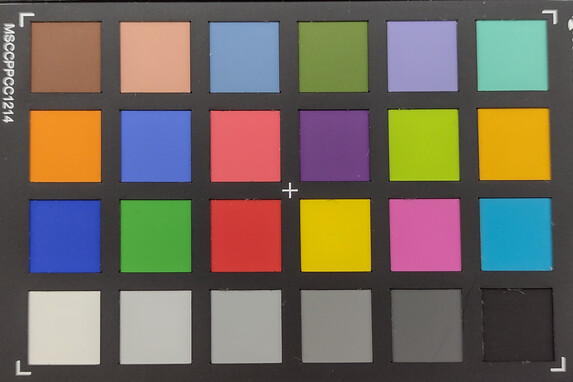
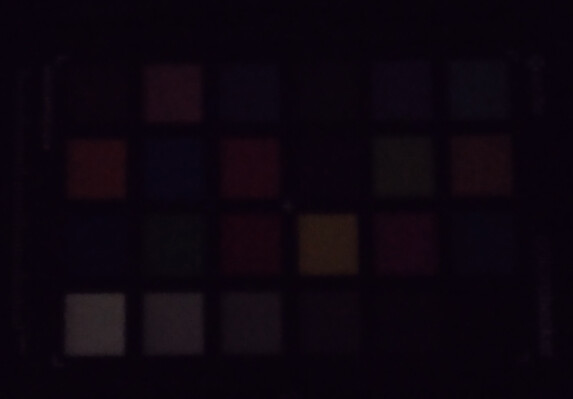
Accessories and warranty - wrist strap in the package
The package includes a charger, a USB-C cable, and a wrist strap that allows carrying the smartphone safely. The manufacturer does not offer any special accessories on its website at the moment.
Motorola grants 24 months warranty on its device in Central Europe.
Input devices & operation - fingerprint sensor at the back
The screen of Motorola's Defy only offers a refresh rate of 60 Hz, so it is not quite as smooth to use as in current high-end phones. However, it is precise and responsive, and you can also increase the touchscreen's sensitivity so that you can still use it with gloves or wet fingers.
On the back, the Motorola logo also serves as a fingerprint sensor. It proved to be quite reliable in our test, but it is also a bit slow when the smartphone is in full standby: It then takes a second until the home screen appears. However, if you have lifted the smartphone beforehand and could prepare it for the upcoming system start, unlocking is more immediate.
If you like, you can also use facial recognition for unlocking or combine it with the fingerprint sensor.
Motorola's Defy comes with a freely assignable button that can be used as a push-to-talk button, so you can use the smartphone like a radio. Or you can assign a function or a preferred app to the button.
Display - (Too) little brightness
With its somewhat expanded 720p resolution, Motorola's Defy is in good company among inexpensive rugged phones, but we would have wished for a slightly higher screen resolution in view of its size. Thus, it is noticeable that the display is not quite as crisp as in higher-end phones.
The IPS panel's screen brightness could also be higher, especially in view of the smartphone's claim as an outdoor phone: A mere 385.7 cd/m² are clearly below what other rugged phones achieve and are actually no longer up to date.
The black value of 0.45 cd/m² is within limits, but the contrast ratio is still rather mediocre due to the quite low brightness.
| |||||||||||||||||||||||||
Brightness Distribution: 90 %
Center on Battery: 402 cd/m²
Contrast: 893:1 (Black: 0.45 cd/m²)
ΔE ColorChecker Calman: 4.83 | ∀{0.5-29.43 Ø4.77}
ΔE Greyscale Calman: 6.4 | ∀{0.09-98 Ø5}
96.4% sRGB (Calman 2D)
Gamma: 2.378
CCT: 8348 K
| Motorola Defy IPS, 1600x720, 6.5" | Samsung Galaxy XCover 5 PLS, 1480x720, 5.3" | Nokia XR20 IPS, 2400x1080, 6.7" | CAT S42 IPS, 1440x720, 5.5" | Blackview BL6000 Pro IPS, 2300x1080, 6.4" | |
|---|---|---|---|---|---|
| Screen | 3% | 38% | 6% | 9% | |
| Brightness middle (cd/m²) | 402 | 525 31% | 599 49% | 541 35% | 583 45% |
| Brightness (cd/m²) | 386 | 491 27% | 598 55% | 532 38% | 518 34% |
| Brightness Distribution (%) | 90 | 87 -3% | 99 10% | 95 6% | 83 -8% |
| Black Level * (cd/m²) | 0.45 | 0.53 -18% | 0.33 27% | 0.52 -16% | 0.6 -33% |
| Contrast (:1) | 893 | 991 11% | 1815 103% | 1040 16% | 972 9% |
| Colorchecker dE 2000 * | 4.83 | 5.54 -15% | 4.52 6% | 5.89 -22% | 4.78 1% |
| Colorchecker dE 2000 max. * | 9.53 | 10.23 -7% | 7.6 20% | 11.35 -19% | 8.7 9% |
| Greyscale dE 2000 * | 6.4 | 6.7 -5% | 4.2 34% | 5.6 12% | 5.5 14% |
| Gamma | 2.378 93% | 2.318 95% | 2.279 97% | 2.272 97% | 2.22 99% |
| CCT | 8348 78% | 8555 76% | 7309 89% | 7884 82% | 6830 95% |
* ... smaller is better
Screen Flickering / PWM (Pulse-Width Modulation)
| Screen flickering / PWM not detected | |||
In comparison: 53 % of all tested devices do not use PWM to dim the display. If PWM was detected, an average of 8084 (minimum: 5 - maximum: 343500) Hz was measured. | |||
Our tests with the CalMAN software and the spectrophotometer show that the color settings "saturated" or "natural" do not make a big difference in the color reproduction. A clear blue cast is visible in both modes and generally the deviations in some hues make a professional color assessment difficult.
Display Response Times
| ↔ Response Time Black to White | ||
|---|---|---|
| 32 ms ... rise ↗ and fall ↘ combined | ↗ 17 ms rise | |
| ↘ 15 ms fall | ||
| The screen shows slow response rates in our tests and will be unsatisfactory for gamers. In comparison, all tested devices range from 0.1 (minimum) to 240 (maximum) ms. » 85 % of all devices are better. This means that the measured response time is worse than the average of all tested devices (20.2 ms). | ||
| ↔ Response Time 50% Grey to 80% Grey | ||
| 59 ms ... rise ↗ and fall ↘ combined | ↗ 30 ms rise | |
| ↘ 29 ms fall | ||
| The screen shows slow response rates in our tests and will be unsatisfactory for gamers. In comparison, all tested devices range from 0.165 (minimum) to 636 (maximum) ms. » 95 % of all devices are better. This means that the measured response time is worse than the average of all tested devices (31.6 ms). | ||
The low brightness is noticed negatively outdoors when you are in sunlight: The screen is very reflective and the content is hardly recognizable. Things look better in the shade.
Slight dimming is visible at the viewing angles when looking at the screen from the side. This is noticeable in everyday use, but it is still bearable.
Performance - The Motorola Defy can keep up
With the Snapdragon 662 from Qualcomm, the Motorola Defy comes with an SoC that is already 2 1/2 years old. Nevertheless, it is still quite fit in terms of performance, especially when you compare the processor performance with other inexpensive outdoor phones. Our benchmarks show good results for Motorola's rugged smartphone, even in the system benchmarks.
In terms of graphics performance, an Adreno 610 which is also not quite up to date. It can also outperform the graphics solutions in the Samsung Galaxy XCover 5 and CAT S42 but it can outperform them.
| PCMark for Android - Work 3.0 (sort by value) | |
| Motorola Defy | |
| Nokia XR20 | |
| Average Qualcomm Snapdragon 662 (3195 - 7554, n=6) | |
| Average of class Smartphone (4507 - 28557, n=184, last 2 years) | |
| GFXBench (DX / GLBenchmark) 2.7 | |
| T-Rex Onscreen (sort by value) | |
| Motorola Defy | |
| Samsung Galaxy XCover 5 | |
| Nokia XR20 | |
| CAT S42 | |
| Average Qualcomm Snapdragon 662 (29 - 51, n=10) | |
| Average of class Smartphone (12 - 166, n=153, last 2 years) | |
| 1920x1080 T-Rex Offscreen (sort by value) | |
| Motorola Defy | |
| Samsung Galaxy XCover 5 | |
| Nokia XR20 | |
| CAT S42 | |
| Average Qualcomm Snapdragon 662 (34 - 36, n=10) | |
| Average of class Smartphone (22 - 954, n=153, last 2 years) | |
| GFXBench 3.0 | |
| on screen Manhattan Onscreen OGL (sort by value) | |
| Motorola Defy | |
| Samsung Galaxy XCover 5 | |
| Nokia XR20 | |
| CAT S42 | |
| Average Qualcomm Snapdragon 662 (16 - 34, n=10) | |
| Average of class Smartphone (18 - 166, n=155, last 2 years) | |
| 1920x1080 1080p Manhattan Offscreen (sort by value) | |
| Motorola Defy | |
| Samsung Galaxy XCover 5 | |
| Nokia XR20 | |
| CAT S42 | |
| Average Qualcomm Snapdragon 662 (19 - 21, n=10) | |
| Average of class Smartphone (12 - 606, n=154, last 2 years) | |
| GFXBench 3.1 | |
| on screen Manhattan ES 3.1 Onscreen (sort by value) | |
| Motorola Defy | |
| Samsung Galaxy XCover 5 | |
| Nokia XR20 | |
| CAT S42 | |
| Average Qualcomm Snapdragon 662 (11 - 26, n=10) | |
| Average of class Smartphone (11 - 166, n=155, last 2 years) | |
| 1920x1080 Manhattan ES 3.1 Offscreen (sort by value) | |
| Motorola Defy | |
| Samsung Galaxy XCover 5 | |
| Nokia XR20 | |
| CAT S42 | |
| Average Qualcomm Snapdragon 662 (13 - 14, n=10) | |
| Average of class Smartphone (8.4 - 413, n=154, last 2 years) | |
| AnTuTu v8 - Total Score (sort by value) | |
| Motorola Defy | |
| Samsung Galaxy XCover 5 | |
| Nokia XR20 | |
| CAT S42 | |
| Average Qualcomm Snapdragon 662 (167471 - 185542, n=9) | |
Motorola's Defy has a decent speed when browsing the Internet. It is far from high-end, but at least you do not have to wait too long until images are reloaded when scrolling.
| Jetstream 2 - 2.0 Total Score | |
| Average of class Smartphone (23.8 - 387, n=147, last 2 years) | |
| Nokia XR20 (Chrome 92) | |
| Motorola Defy (Chrome 93) | |
| Average Qualcomm Snapdragon 662 (30.4 - 32.4, n=10) | |
| Samsung Galaxy XCover 5 (Chrome 89) | |
| CAT S42 (Chrome 80) | |
| JetStream 1.1 - Total Score | |
| Nokia XR20 (Chrome 92) | |
| Motorola Defy (Chrome 93) | |
| Average Qualcomm Snapdragon 662 (47.8 - 53.7, n=9) | |
| Samsung Galaxy XCover 5 (Chrome 89) | |
| CAT S42 (Chrome 80) | |
| Speedometer 2.0 - Result 2.0 | |
| Average of class Smartphone (15.2 - 643, n=119, last 2 years) | |
| Nokia XR20 (Chome 92) | |
| Motorola Defy (Chome 93) | |
| Average Qualcomm Snapdragon 662 (26.5 - 29.3, n=9) | |
| Samsung Galaxy XCover 5 (Chome 89) | |
| CAT S42 (Chome 80) | |
| WebXPRT 3 - Overall | |
| Average of class Smartphone (38 - 380, n=30, last 2 years) | |
| Nokia XR20 (Chrome 92) | |
| Motorola Defy (Chrome 93) | |
| Average Qualcomm Snapdragon 662 (51 - 59, n=11) | |
| Samsung Galaxy XCover 5 (Chrome 89) | |
| CAT S42 (Chrome 80) | |
| Octane V2 - Total Score | |
| Average of class Smartphone (2228 - 126661, n=194, last 2 years) | |
| Nokia XR20 (Chrome 92) | |
| Motorola Defy (Chrome 93) | |
| Average Qualcomm Snapdragon 662 (8893 - 10247, n=14) | |
| Samsung Galaxy XCover 5 (Chrome 89) | |
| CAT S42 (Chrome 80) | |
| Mozilla Kraken 1.1 - Total | |
| CAT S42 (Chrome 80) | |
| Samsung Galaxy XCover 5 (Chrome 89) | |
| Average Qualcomm Snapdragon 662 (3779 - 4650, n=11) | |
| Motorola Defy (Chrome 93) | |
| Nokia XR20 (Chrome 92) | |
| Average of class Smartphone (257 - 28190, n=154, last 2 years) | |
* ... smaller is better
If you look at the storage, you will find information on the Internet that it is supposed to be UFS 2.1 storage, but the performance in the benchmarks rather speaks for eMMC flash, which is significantly slower. The manufacturer actually confirms this upon request. The smartphone's transfer rates are at least a bit more stable than other devices with eMMC storage in random accesses, but the overall speed is rather poor at the same time.
| Motorola Defy | Samsung Galaxy XCover 5 | Nokia XR20 | CAT S42 | Blackview BL6000 Pro | Average 64 GB eMMC Flash | Average of class Smartphone | |
|---|---|---|---|---|---|---|---|
| AndroBench 3-5 | -6% | 85% | -43% | 96% | -29% | 501% | |
| Sequential Read 256KB (MB/s) | 306.5 | 268.5 -12% | 485 58% | 287.9 -6% | 873 185% | 277 ? -10% | 2235 ? 629% |
| Sequential Write 256KB (MB/s) | 187.7 | 273.6 46% | 452 141% | 121.1 -35% | 198.5 6% | 178.4 ? -5% | 1871 ? 897% |
| Random Read 4KB (MB/s) | 96.4 | 121 26% | 174.8 81% | 51.6 -46% | 190.2 97% | 60.7 ? -37% | 297 ? 208% |
| Random Write 4KB (MB/s) | 92.6 | 14.7 -84% | 146.2 58% | 14.8 -84% | 181.9 96% | 33.8 ? -63% | 343 ? 270% |
Games - 3D games with cutbacks
The Motorola Defy is not and will probably never be a real gaming smartphone. The system components and especially the graphics solution are simply not powerful enough for that.
Simple casual games can be played without problems, and the 2D shooter Armajet at least manages a relatively stable 60 fps. However, you have to reduce the details considerably in 3D games like PUBG Mobile if you want to play without stutters. Moreover, higher graphics options are not offered at all. We measured the frame rates with the software from GameBench.
The controls via touchscreen and position sensor work without problems.
Emissions - Hardly any warming
Temperature
The case of the Motorola Defy heats up quite moderately even after a longer full load: We measured a maximum of 40 °C (104 °F) on the front. Thus, the smartphone can always be touched without problems.
The long-term performance is also ensured, as the stress tests of 3D Mark Wild Life show: Here, well over 90% of the performance is still available even after 20 runs of the benchmark.
(±) The maximum temperature on the upper side is 40 °C / 104 F, compared to the average of 35.2 °C / 95 F, ranging from 21.9 to 247 °C for the class Smartphone.
(+) The bottom heats up to a maximum of 39.5 °C / 103 F, compared to the average of 34 °C / 93 F
(+) In idle usage, the average temperature for the upper side is 24.9 °C / 77 F, compared to the device average of 32.9 °C / 91 F.
| 3DMark | |
| Wild Life Stress Test Stability | |
| Nokia XR20 | |
| Motorola Defy | |
| Samsung Galaxy XCover 5 | |
| Blackview BL6000 Pro | |
| Wild Life Extreme Stress Test | |
| Nokia XR20 | |
| Motorola Defy | |
Speaker
Even though the earpiece above the screen presents itself with a wide speaker grille: Only the speaker on the lower edge is used for sound output. It does its job quite well. It cannot mix bass frequencies into the sound, but it does have some low mids and reasonably balanced trebles that do not thud too much in the ears even at maximum volume.
Convenient: Both the 3.5 mm audio port on the top and the USB-C port can be used for audio output. Thus, you can choose whether you want to use an analog or a digital output and do not need an adapter for existing headphones.
Sound can be transmitted wirelessly via Bluetooth, and many codecs for high-quality audio are available with aptX HD, aptX Adaptive and LDAC, so you do not have to worry so much about compatibility with wireless headphones.
Motorola Defy audio analysis
(+) | speakers can play relatively loud (83.9 dB)
Bass 100 - 315 Hz
(-) | nearly no bass - on average 30% lower than median
(-) | bass is not linear (15.6% delta to prev. frequency)
Mids 400 - 2000 Hz
(+) | balanced mids - only 3.5% away from median
(+) | mids are linear (6% delta to prev. frequency)
Highs 2 - 16 kHz
(+) | balanced highs - only 3.8% away from median
(+) | highs are linear (4.5% delta to prev. frequency)
Overall 100 - 16.000 Hz
(±) | linearity of overall sound is average (21% difference to median)
Compared to same class
» 39% of all tested devices in this class were better, 8% similar, 53% worse
» The best had a delta of 11%, average was 35%, worst was 134%
Compared to all devices tested
» 57% of all tested devices were better, 7% similar, 36% worse
» The best had a delta of 4%, average was 24%, worst was 134%
Samsung Galaxy XCover 5 audio analysis
(±) | speaker loudness is average but good (79.6 dB)
Bass 100 - 315 Hz
(-) | nearly no bass - on average 32% lower than median
(±) | linearity of bass is average (12.5% delta to prev. frequency)
Mids 400 - 2000 Hz
(±) | higher mids - on average 5.8% higher than median
(+) | mids are linear (6.8% delta to prev. frequency)
Highs 2 - 16 kHz
(±) | higher highs - on average 5.4% higher than median
(+) | highs are linear (4.6% delta to prev. frequency)
Overall 100 - 16.000 Hz
(±) | linearity of overall sound is average (27.9% difference to median)
Compared to same class
» 72% of all tested devices in this class were better, 5% similar, 23% worse
» The best had a delta of 11%, average was 35%, worst was 134%
Compared to all devices tested
» 84% of all tested devices were better, 3% similar, 13% worse
» The best had a delta of 4%, average was 24%, worst was 134%
Battery life - Even several days without a power outlet
Energy consumption
Motorola's Defy proves to be reasonably energy-efficient. Especially under load, the measured rates are within reason, but the smartphone is not too hungry in idle mode, either.
| Idle | |
| Load |
|
Key:
min: | |
| Motorola Defy 5000 mAh | Samsung Galaxy XCover 5 3000 mAh | Nokia XR20 4630 mAh | CAT S42 4200 mAh | Average Qualcomm Snapdragon 662 | Average of class Smartphone | |
|---|---|---|---|---|---|---|
| Power Consumption | -17% | 26% | -14% | -25% | -33% | |
| Idle Minimum * (Watt) | 1.3 | 1.3 -0% | 0.7 46% | 1.5 -15% | 0.846 ? 35% | 0.847 ? 35% |
| Idle Average * (Watt) | 1.9 | 1.9 -0% | 1.1 42% | 2 -5% | 2.51 ? -32% | 1.448 ? 24% |
| Idle Maximum * (Watt) | 2.2 | 2.7 -23% | 1.6 27% | 3 -36% | 2.72 ? -24% | 1.633 ? 26% |
| Load Average * (Watt) | 3 | 4.3 -43% | 2.7 10% | 3.6 -20% | 4.99 ? -66% | 6.96 ? -132% |
| Load Maximum * (Watt) | 5.2 | 6.2 -19% | 4.9 6% | 4.9 6% | 7.16 ? -38% | 11.3 ? -117% |
* ... smaller is better
Power consumption: Geekbench (150 cd/m²)
Power consumption: GFXBench (150 cd/m²)
Battery life
Thanks to a 5,000 mAh battery, the Motorola Defy has plenty of battery capacity. Thus, it actually lasts for a very long time: 15:48 hours in our Wi-Fi test is not a bad rate and indicates at least two days of normal use away from the power outlet.
The smartphone cannot be charged wirelessly, but wired fast charging with up to 20 watts is available. A full charge takes approximately 1:20 hours with the included charger.
| Motorola Defy 5000 mAh | Samsung Galaxy XCover 5 3000 mAh | Nokia XR20 4630 mAh | CAT S42 4200 mAh | Blackview BL6000 Pro 5280 mAh | |
|---|---|---|---|---|---|
| Battery runtime | -31% | -5% | -18% | -11% | |
| Reader / Idle (h) | 30.8 | 20.8 -32% | 29.8 -3% | 20.7 -33% | |
| H.264 (h) | 15.6 | 11.5 -26% | 14.9 -4% | 15 -4% | |
| WiFi v1.3 (h) | 15.8 | 11 -30% | 15.5 -2% | 13.9 -12% | 14.1 -11% |
| Load (h) | 5.5 | 3.6 -35% | 5 -9% | 4.2 -24% |
Pros
Cons
Verdict - Not flawless, but very robust
When it comes to outdoor smartphones, it is necessary to lower one's expectations a bit: If you compare the devices with normal smartphones in the same price range, you immediately notice a striking difference in terms of performance and features.
However, smartphones like the Motorola Defy also offer features that are not found in normal phones around 300 Euros (~$348): The very stable Gorilla Glass Victus, for example, a rubberized casing, or a touchscreen that can even be used with wet fingers.
In exchange you have to accept a few things: The Wi-Fi performance is quite low, there is little and slow memory and the screen is dark, which is especially annoying for an outdoor phone.
The bright spots are the good runtimes, the decent performance and the chic casing, which proves to be very stable and well-made in our test. The device does not heat up excessively under load, can maintain its performance, has a camera that shoots sharp pictures and has a quite pure Android on board.
The cooperation between Motorola and the Bullitt Group results in a solid outdoor phone with a chic casing and decent camera.
You get even more performance with the Nokia XR20. There is also an additional wide-angle camera. If you are looking for a much smaller rugged phone, you should take a look at the Samsung Galaxy XCover 5 or the CAT S42.
Price and availability
The Motorola Defy can be purchased directly from the manufacturer at https://motorolarugged.com/de-de/ for 329 Euros (~$382). At Amazon.com (DE) at the time of testing, but somewhat cheaper offers can also be found on the Internet.
Motorola Defy
- 09/29/2021 v7 (old)
Florian Schmitt




